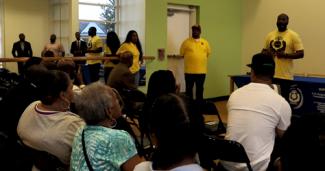Cure the Streets: OAG’s Violence Interruption Program
Earlier this summer, the District saw a tragic spike in violence where 13 people were shot in 11 separate incidents over Memorial Day weekend. In response, the Council appropriated $360,000 to the Office of the Attorney General (OAG) to set up a pilot program for violence interruption. In just four months, OAG has launched and fully staffed “Cure the Streets” in the District and it’s already showing some early signs of progress.
Cure the Streets is based on the successful CURE Violence model, which has seen a 20-60 percent reductions in shootings and killings more than 100 cities nationwide and globally. This model uses a public-health approach and treats violence as a disease through three main actions:
- Interrupt: Interrupt potentially violent conflicts by preventing retaliation and mediating simmering disputes;
- Treat: Identify and treat individuals at the highest risk for conflict by providing support services and changing behavior; and
- Change: Engage communities in changing norms around violence (for instance, organize community responses to every shooting to counter normalization).
This work is carried out through the use of violence interrupters, credible residents with deep ties to the target neighborhoods. Our Cure the Streets interrupters have undergone 40 hours of rigorous training and are working in two targeted sites in Wards 8 and 5 selected for their chronic and sustained rates of shootings and homicides.
Since Cure the Streets launched, these interrupters have de-escalated several disputes and averted potentially fatal incidents. One such de-escalation took place shortly after a non-fatal shooting, where interrupters responded to the scene, spoke to the people involved, and negotiated a truce that held until a mediation was held that weekend. The mediation resolved the conflict between the warring parties. In another incident, an individual called a violence interrupter because he had a credible fear of being killed. The violence interrupters took that person out of the community for two days while they talked with the potential culprit and cleared up the misunderstanding that was fueling the conflict.
These interventions were possible because those residents knew and trusted the Cure the Streets interrupters. As these workers continue to develop key relationship with target neighborhood residents, their effectiveness will grow. So far, the interrupters have:
- Made 300 contacts with community members in target neighborhoods;
- Identified 16 high-risk individuals, with nine actively engaged in case management by workers;
- Conducted 6 shooting responses in Ward 8 and 1 shooting response in Ward 5; and
- Facilitated 10 mediations (six in Ward 8 and four in Ward 5) to defuse potentially violent situations.
Although Cure the Streets is just getting started, it’s already making a positive difference in these communities. OAG works to protect District residents and we must continue investing in these data-driven, proven solutions that can stop violence before it happens and save lives.

